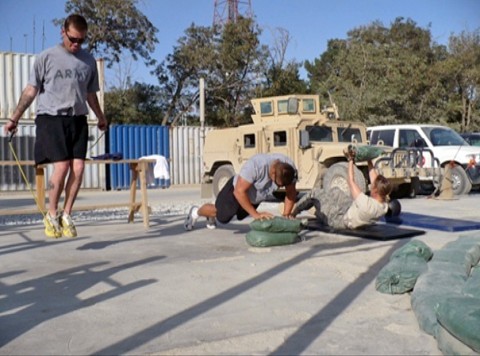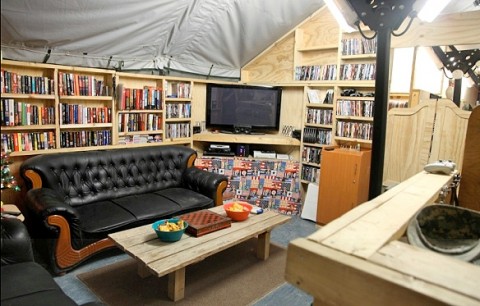Written by Command Sgt. Maj. Scott Schroeder
 Afghanistan – Concussive events are not new, but the military really hasn’t paid much attention to these injuries until recently. As we started intensive ground combat operations, leaders did not understand the lasting impacts of concussive- type events (mostly caused by improvised explosive devices) and medical providers didn’t have the experience, or capacity, to treat the number of Soldiers suffering such injuries.
Afghanistan – Concussive events are not new, but the military really hasn’t paid much attention to these injuries until recently. As we started intensive ground combat operations, leaders did not understand the lasting impacts of concussive- type events (mostly caused by improvised explosive devices) and medical providers didn’t have the experience, or capacity, to treat the number of Soldiers suffering such injuries.
A report by the Armed Forces Health Surveillance Center estimates 95,942 Soldiers have been treated for mTBI since 2003. Over the past seven years, I have seen great advances in the way we train, track and treat Soldiers with these injuries.

The enemy responded by constructing IEDs with greater quantities of explosives. Being in armored vehicles caused an overpressure effect that magnified the concussive effect of blasts. At this time we began to understand and accept that concussions were injuries that needed treatment and to be documented in medical records. Treatments were rudimentary. The Army started conducting the Mild Acute Concussive Evaluation testing but very few Soldiers suffering concussion were evacuated to higher levels of care.
It wasn’t until after the unit redeployed that leaders really saw the effects of multiple exposures to concussive events on Soldiers. I watched as a great first sergeant with a great amount of potential was forced into retirement due to his injuries from the previous deployment. He had been struck by five IEDs. I was assigned a new driver from the engineer company (one of their best Soldiers) after the deployment who had been involved in 12 to 13 IED blasts as part of the route clearance platoon. I watched as this Soldier began to struggle with simple tasks at work. He also struggled to perform life skills.
I saw unit leaders become frustrated at previously solid-performing Soldiers whose performance began to diminish and at Soldiers who had physically limiting profiles due to treatment and medications. Even though we did not fully understand the scope of the problem, we did see that more Soldiers were being diagnosed with concussions. In 2005, 12,192 Soldiers were treated for mTBI compared to 23,160 treated in 2007.

I deployed to Baghdad with the 2nd BCT, 101st Abn. Div., as the BCT command sergeant major from August 2007 to November of 2008. By this time, we better understood the effects of concussive injuries. We integrated training on protocols and treatment into our CTC rotation and conducted leader mTBI training and awareness. The unit also conducted Automated Neuropsychological Assessment Metric (ANAM) testing to get a “mental baseline” prior to the deployment. We understood the possible consequences of concussions and treated Soldiers for mTBI. The installation opened an mTBI clinic in October of 2008 to focus on treating these injuries. Soldiers showing symptoms were evacuated from theater. Very few of these Soldiers returned. Many Soldiers, especially leaders, involved in concussive events avoided treatment because they didn’t want to be evacuated.
In the past, the provider relied on the history given by the Soldiers to make an assessment. In many cases, these Soldiers were rendered unconscious by the blast. Some Soldiers report blast exposures that never occurred. Without additional data to base decisions upon, the medical providers defer to the history provided by the Soldier. This problem is compounded if the Soldier’s leadership transitions soon after redeployment because no one is available to confirm the Soldier’s firsthand account. Finally, providers also don’t have access to a Soldier’s performance records so there is no information on a Soldier’s pre- and post-incident performance to make a comparison.
Today in Afghanistan, we are treating Soldiers right off the battle field at BCT Level II medical facilities. The first of these facilities I visited was at Forward Operating Base Shank under the 173rd Airborne Brigade Combat Team. I was immediately impressed with the program and we pushed to have all of our Level II facilities replicate this capability. The purpose of this facility is to get the Soldier off the battlefield and get him rest. Rest is the immediate and most important treatment for Soldiers who have been exposed to a concussive event. Going to the clinic also keeps the Soldier from going on patrols before he is prepared. The effects of a successive injury are much greater if the patient hasn’t fully recovered. Before returning to duty, the patients receive comprehensive screenings and exertional testing to ensure they are 100 percent when they return to their units.
Since January of 2010, Level II facilities in RC-East have treated 1,023 Soldiers. Our Level II facilities have a 98 percent return-to-duty, or RTD, rate. Two years ago, when we did not have this capability, a large percentage of these Soldiers would have been air evacuated from theater.
Level II; Capabilities
- Sleep (goal of 8 hours/night)
- 1-3 day stay (up to 21 per CPG)
- Monitor / MACE / Medical follow-up
- Persistent sx evac to BAF
- 1023 Treated w/mTBI related sx
- 25 evacuated to Level III facilities
- 98% RTD, approx 2% to BAF
- “Acute” demographic
- RTD restrictions rare
- Rest & symptom management
Continuity of care:
- Unit liaisons
- RTD guidance
- With MC4 and ALTHA Soldiers treatment is recorded affecting short, mid care, and long term benefits.
- Limits load on already overwhelmed PEB System.
We have also pushed for our theater to have a Level III mTBI facility at Bagram Airfield. This facility allows Soldiers with more significant concussions and those who are not improving at our Level II facilities to remain in theater for continued treatment. The Level III mTBI facility incorporates a neurologist and neuropsychology testing and also allows us to screen Soldiers who have multiple blasts in theater without evacuation. All care is recorded in the MC4 and ALTHA. Our providers have regular meetings between the Level II mTBI facilities, Level III mTBI facility, and the mTBI clinic at Fort Campbell.
They discuss patient’s treatments and have access to the Soldier and his leadership. There have been 25 Soldiers referred to our Level III facility at Bagram Airfield, which started operation in October 2010. Our Level III facility has an 88 percent RTD rate.
Level III: Capabilities
- Sleep hygiene
- LOS: 10- to 30-day stay; avg 13 days
- Specialty care – neurology, neuropsychology
- Case management
- Deteriorating sx evac to LRMC
- 31 Patients
- 25 RTD
- 3 Evac’d from theater
- 83% RTD, 9.6% to LRMC
- “Chronic” demographic
- RTD restrictions common
- Education and ADL focus
Capabilities:
- Neurology / imaging / neuropsychology / cognitive testing / physical therapy / combat stress control / group sessions
- Ancillary services: pharmacy, EENT, optometry, ophthalmology
- Education / routines / ADLs
There are several benefits to these in-theater facilities. They work because unit leadership is confident only Soldiers needing higher levels of care are evacuated. The result of this is more Soldiers are screened and treated. With MC42 and ALTHA3 Soldiers treatments are recorded, affecting short- and mid-term care as well as ensuring Soldiers are eligible for long-term benefits. Treating in-country reduces the stress on our already overwhelmed Physical Evaluation Board (PEB) system and our Warrior Transition Units. Finally, treatment in theater ensures that the Soldiers remain connected to their primary source of support, the Soldiers they fight with.
www.health.mil/Research/TBI_Numbers.aspx
Medical Communications for Combat Casualty Care (MC4) hardware provides a tool to ensure that encounter data from deployed environments is captured and accessible for the life of the Service Member.
Armed Forces Health Longitudinal Technology Application (AHLTA) allows healthcare providers to enter a complete outpatient clinical encounter. Medical personnel use this software on their laptops to feed the encounter data to the Joint Medical Workstation (JMeWS) for collection of medical surveillance.
About Command Sgt. Maj. Scott Schroeder
Command Sgt. Maj. Scott Schroeder currently serves as the command sergeant major for 101st Airborne Division (Air Assault) and Combined Joint Task Force-101/ Regional Command-East in Afghanistan. He has completed multiple combat deployments resulting in extensive exposure to combat-related injuries. He deployed to Afghanistan in 2001 OEF I with the 101st Airborne Division (Air Assault) as a first sergeant. He has also deployed to Operation Iraqi Freedom twice as a battalion command sergeant major and deployed as the 2BCT command sergeant major during Operation Iraqi Freedom 07-09.


